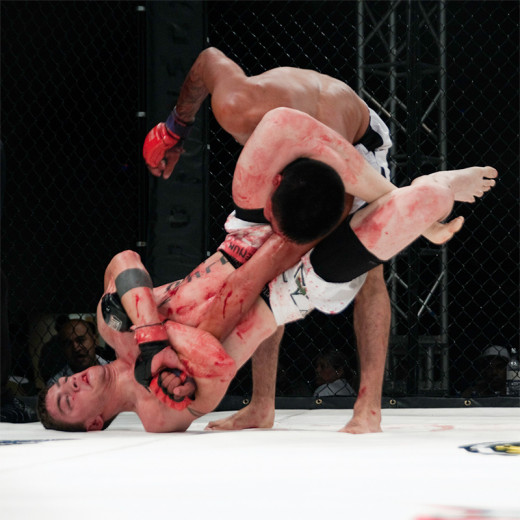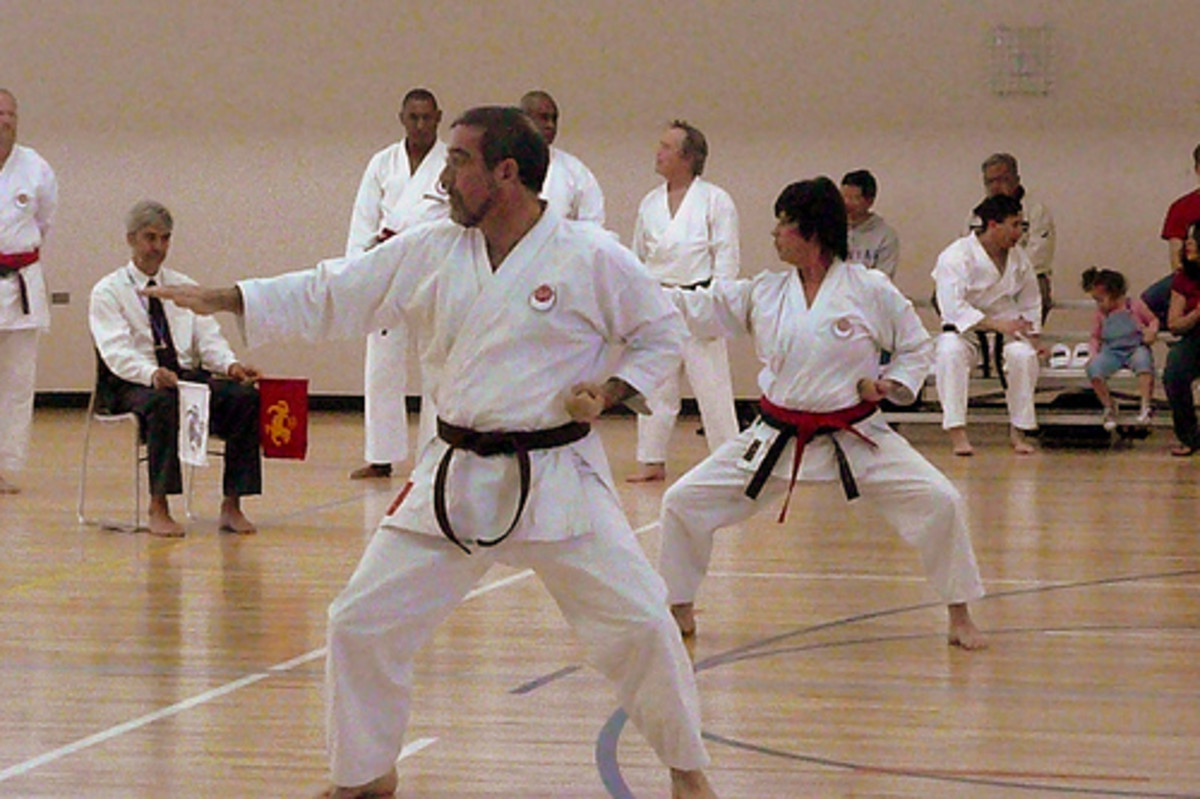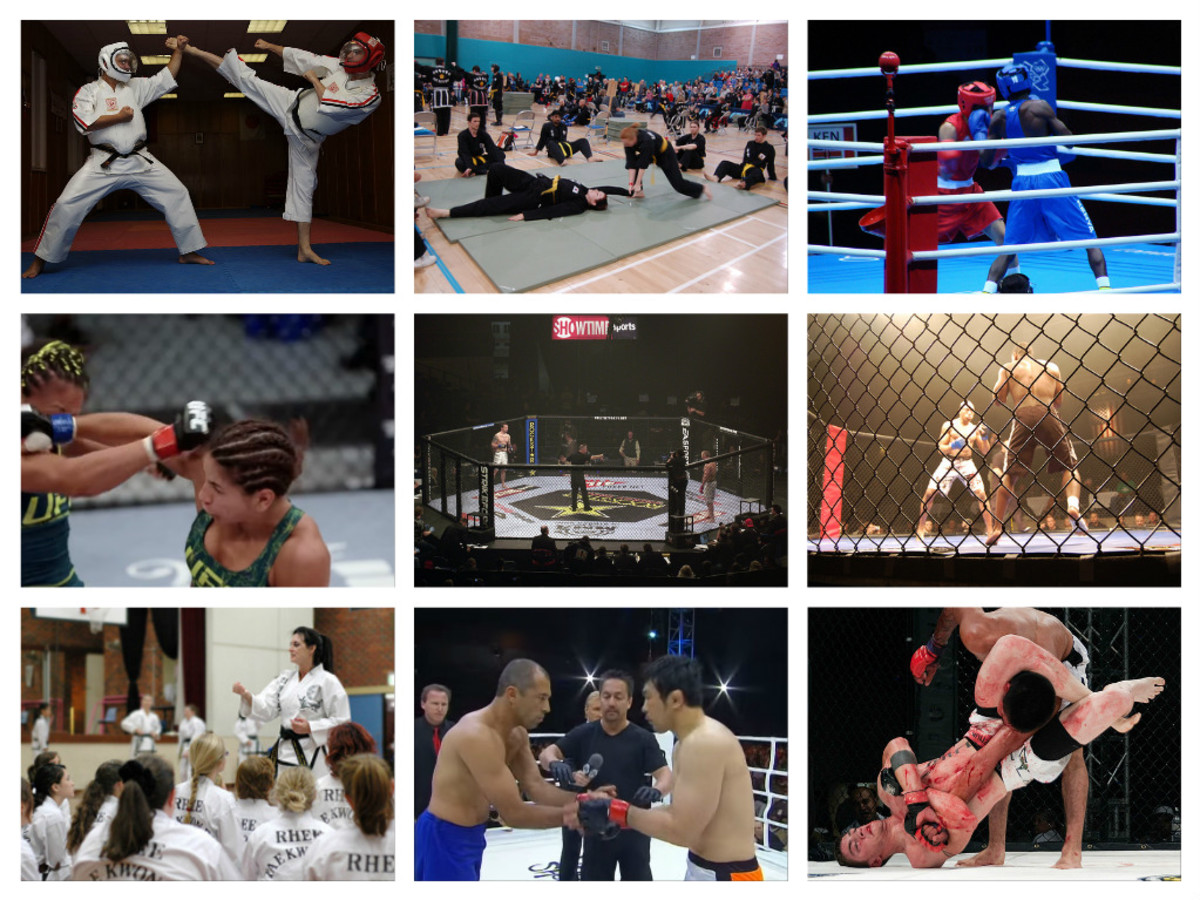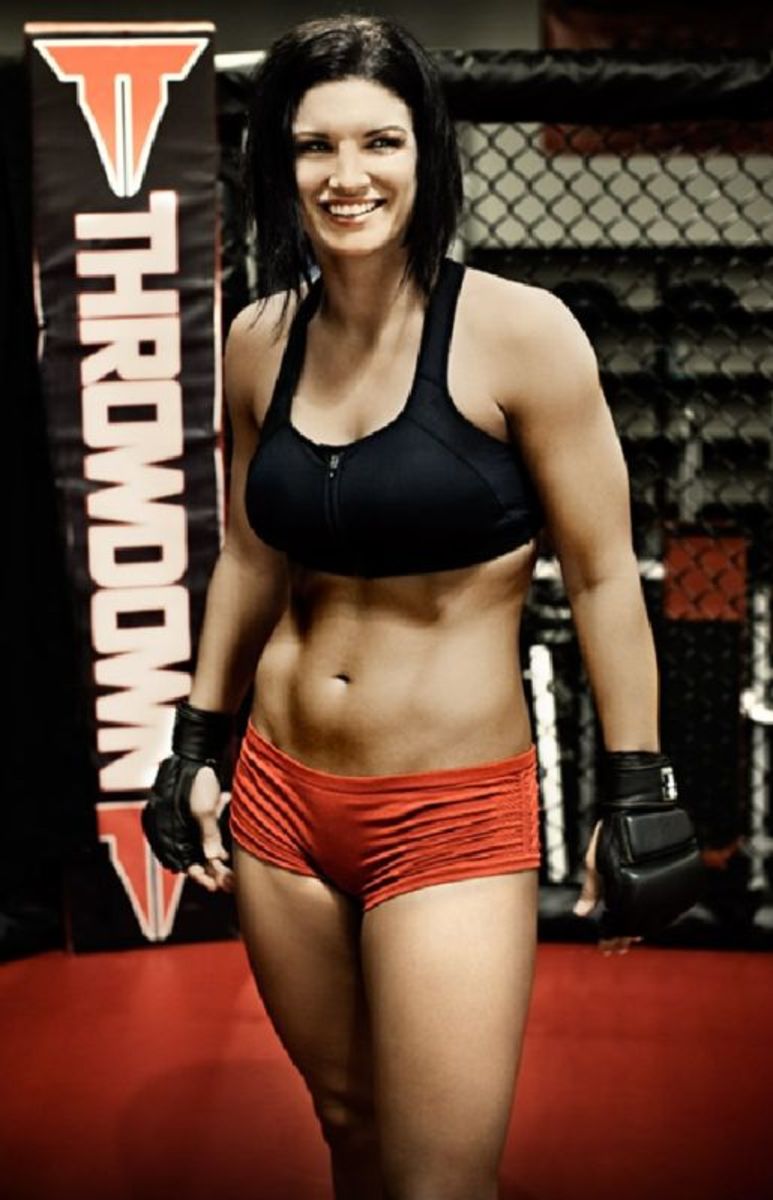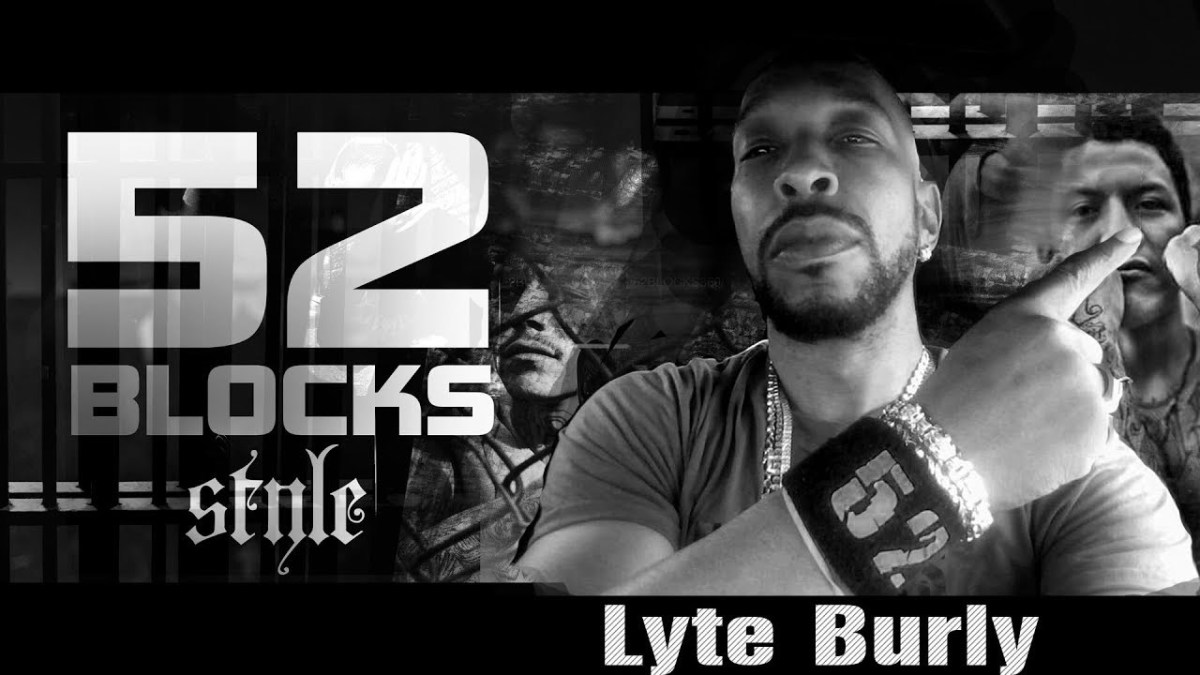- HubPages»
- Sports and Recreation»
- Individual Sports»
- Martial Arts
Tae Kwon Do & MMA: Effectively Applying TKD Into MMA Training
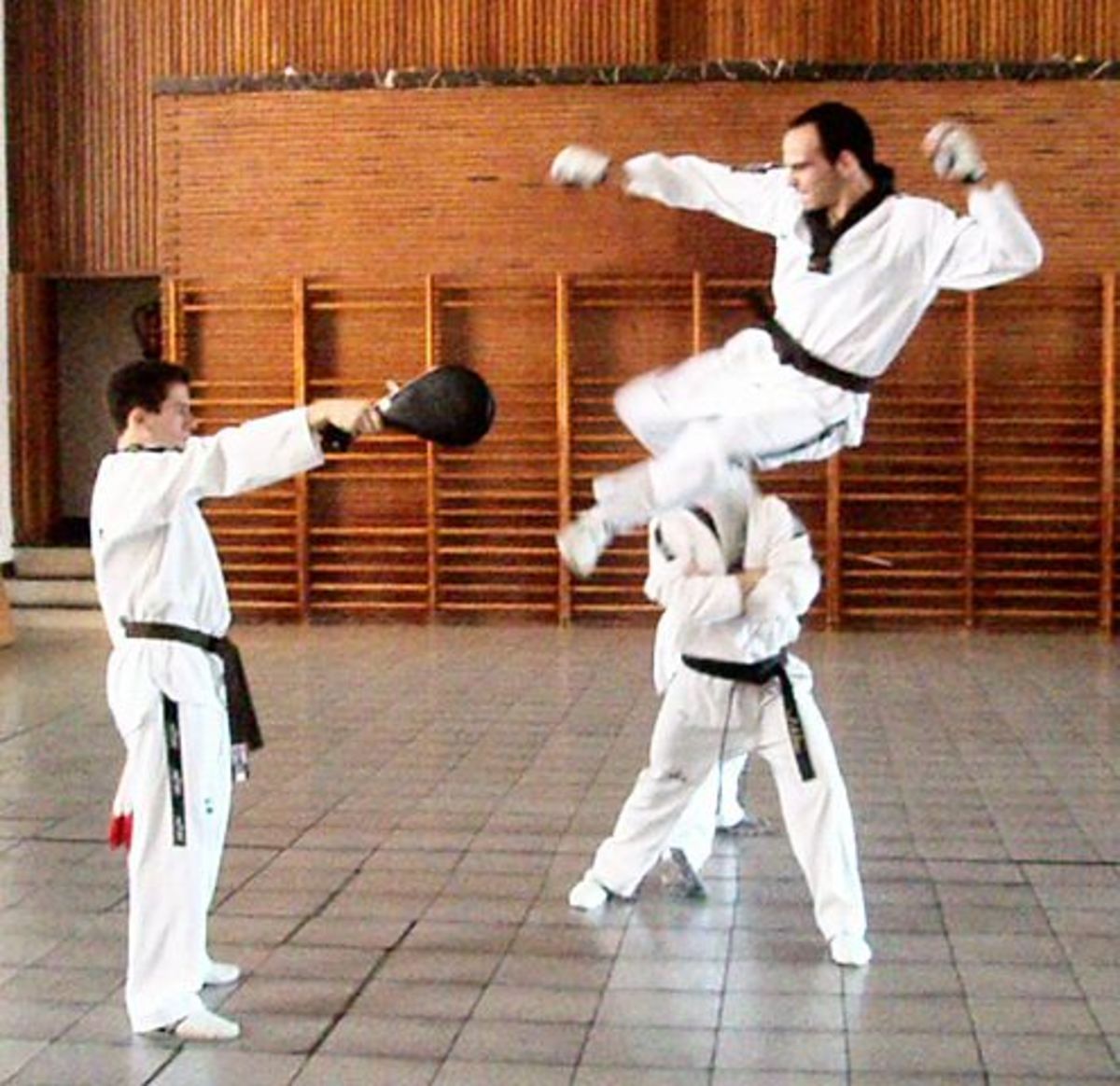
Tae Kwon Do's standing in Mixed Martial Arts
The Ultimate Fighting Championships (UFC), in the early days with little to no regulation, marked the early days of mixed martial arts (MMA). Before the sport was called MMA, it was known as “No Holds Barred” (NHB). NHB meant that you can use any hold and virtually any move (except for eye-gouging, biting, head stomping and fish hooking) including groin shots. The two major NHB promotions in the world were the American-based UFC and the Japan-based Pride Fighting Championships (Pride FC). In the case of Pride FC, in the past, head stomps were allowed.
MMA, back when it was known as NHB, focused mainly on the ground. It was assumed that all the fights would end up be standing; instead, styles such as Wrestling, Brazilian Jiu-Jitsu, and Japanese Shootfighting ended up taking the lead in this sport. The sport was still underground; meaning, it wasn't popular. You'd only see those fights on pay-per-view; but, that would change in early 2005 with the live season finale of “The Ultimate Fighter” on Spike TV. With the success of The Ultimate Fighter, the UFC found viability of taking MMA into the mainstream. While it still had PPV events, the UFC would be having free-view events mainly on Spike TV. Recently, free-view events have been available on Fuel and other networks.
In terms with Tae Kwon Do and other striking arts, practitioners were taken down by skilled wrestlers and grapplers in the early days of the UFC. With that said, the Korean style of Tae Kwon Do didn't have much success in MMA.
There wasn't much of a focus on your typical striking with your punches and kicks; instead, most MMA schools had a strong focus on ground fighting. It was and still is the most important component in MMA training. You can be an exceptional striker; but, it doesn't matter if and when you're taken to the ground. Back then, a good striking game did not have much relevance. Many people fighting in the UFC brought with them backgrounds that allowed them to dominate on the mat.
Striking came back into relevance with fighters such as Maurice “Mo” Smith. Smith made his first UFC appearance in UFC 14 at Birmingham, Alabama. His opponent was Mark Coleman who specialized in wrestling. Smith used his kickboxing experience and worked at Coleman's legs. At the end, Smith won by unanimous decision and became the UFC Heavyweight Champion. Fighters sought to learn Kickboxing and/or Muay Thai to supplement with ground skills with basic skills.
Styles such as Karate and Tae Kwon Do had yet to become relevant. As an effect, the sport of MMA had become a barometer on what styles worked and what didn't. However, there are plenty of holes to poke through if and when using MMA as a barometer. A friend of mine in MMA class told me this: there's no such thing as a bad style. For the most part, he's right.
Tae Kwon Do slowly became relevant during the season finale of TUF season 1. It was the fight between Stephan Bonnar and Forrest Griffin. Bonnar holds a black belt in Tae Kwon Do and almost got Griffin across the face with a spinning hook kick. Even though Bonnar lost, he fought so impressively that Dana White also offered him a contract into the UFC. Bonnar proved that Tae Kwon Do can be applied into MMA.
Anderson “The Spider” Silvia and David “The Crow” Louisseau also started their martial arts training in Tae Kwon Do. Anthony “Showtime” Pettis, Benson “Bendo” Henderson, Dennis “The Menace” Siver, and Cung “The Human Highlight Reel” Le, are the faces of Tae Kwon Do in MMA.
Karate wasn't really relevant in MMA until you had fighters like Chuck "Iceman" Liddell (Koei-Kan and Kenpo), Lyoto "Dragon" Machida (Shotokan), Seth Petruzelli (Shito-Ryu), and Georges "Rush" St. Pierre (Kyokushin Kai).
It made me think of this peace conference lecture I attended early March of 2012. The guest speaker was Captain Paul K. Chappell, an Iraq War veteran. After serving time in the military, he left. Since then, Chappell's been an advocate of world peace; but, he approaches it in a realistic way that appeals to all sides of the spectrum. In 2012, on the Nuclear Age Peace Foundation website, Chappell published an article called “The Hunger Games vs. the Reality of War.” What Chappell said in this article can and should be applied to all forms of combat, that includes combat sports such as MMA.
In his author's note, Chapell said this:“I wrote this because the first book in The Hunger Gamesseries has become required reading in many schools. When students are required to read a book for a class they have a reasonable expectation of being educated, but The Hunger Gamesportrays serious subjects such as war, violence, and trauma in very unrealistic ways. I hope the following will encourage critical thinking, promote discussion, and help people better understand war. I dedicate this to the veterans whose psychological wounds are misunderstood because of unrealistic media depictions of war, violence, and trauma.”
In the first section called “Debunking The Myths of War,” Chapell opened up by saying: “Imagine yourself sitting in a doctor’s office. Looking at you remorsefully, the doctor says you have been diagnosed with a terminal illness, and there is only a four percent chance you will be alive in two weeks. Even worse, he informs you that your death will be incredibly painful. The illness kills most people by violently rupturing one or more of their internal organs, causing them to bleed to death. As if the situation could not get any worse, he then says you must be quarantined in a government laboratory. You will be prevented from communicating with your friends and family members in any way as you lie on your deathbed. You will be forced to face death alone.
How do you think most people would react upon hearing this grim news? And how do you think most people would feel while lying on their deathbed alone, afraid, and on the verge of suffering an extremely painful death? Could you imagine some people having panic attacks, nervous breakdowns, and other severe psychological issues?
The scenario I just described is very similar to the situation twenty-four children must face in the science fiction series The Hunger Games written by Suzanne Collins. In the first book (and film) of the series, twenty-four children from the ages of twelve to eighteen are chosen to compete in a fight to the death called "the hunger games," where they must kill each other with bows and arrows, swords, knives, and other close-range weapons until one person is left standing. Most of the children are selected at random through a kind of lottery, while a few volunteer. Like the terminal illness scenario, each child has only a four percent chance of surviving (1), dying will be extremely painful, and they will be forbidden from seeing their friends and family members while facing death.
If twenty-four children from the ages of twelve to eighteen were told they had a terminal illness – giving them a ninety-six percent chance of dying an extremely painful death in the next two weeks – and then prevented from seeing their friends and family members, do you think many of the children would suffer from panic attacks, nervous breakdowns, and other severe psychological issues? If so, isn’t it odd that not a single child in the first book of The Hunger Games series has a mental meltdown when their situation is in fact worse (for reasons I will explain later) than the terminal illness scenario?”
Chappell then talked about “Three Protective Methods” which are: having reliable comrades, having reliable leaders, and having reliable training.
Applying what is said in the article is crucial in being able to effectively apply Tae Kwon Do into MMA.
When effectively applying TKD into MMA, you have to look at it through the perspective of two groups: TKD users and MMA fighters. This is because they are going to have their fair share of separate challenges.
This video above gives a demonstration of Tae Kwon Do vs. MMA Striking. This was done in a Kickboxing format. It gives an example of how to apply TKD into MMA training. It shows that while TKD emphasizes on kicks, the style isn't all kicks.
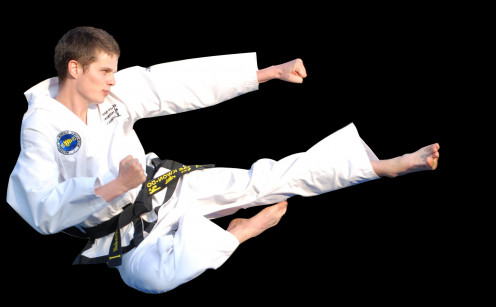
For MMA Fighters:
For those that train in MMA and have the desire to incorporate TKD, then you have a completely different set of challenges. The ideal route is that you take TKD separately to understand the style by enrolling in a local community program or an actual school. TKD users will have their own difficulties transitioning into MMA; at the same time, MMA fighters will have their own difficulties learning and applying TKD into their arsenal.
If you have little to no kicking experience or have no martial arts training at all, then it's going to be incredibly difficult to take up TKD to use in MMA. For more information on that, I recently wrote and published a hub called “MMA – The Four Staple Martial Arts Disciplines” which talks about the four styles of martial arts most commonly taught at MMA schools and used by amateur and professional MMA fighters.
In the article, I didn't mention TKD as one of the staple styles. The only reason certain fighters were able to utilize TKD in MMA is because they have backgrounds in it beforehand. Anthony Pettis, for example, holds a 3rd Dan in TKD.
For the fighters with little to no striking experience or no martial arts training, then TKD is an impractical style to start out with. The basic kicks of TKD (roundhouse kick, front snap kick, and side kick) should be considered as intermediate to advanced striking for MMA. While these moves are basic in Muay Thai and most styles of Karate, the techniques behind the move are different. You'll need a combination of reflexes, good waist motion, flexibility, and lower body speed to effectively apply the basic kicks of TKD.
Intermediate kicks such as the back kick and spinning hook kick should be classified as moderate advanced striking attacks. Kicks such as the tornado roundhouse and the 360 back kick should be classified as highly advanced.
In short, you're going to have to commit to TKD just as you would commit to your Boxing, Kickboxing, Grappling, and Wrestling. If you do not, then you won't get anything out of TKD training. You get what you put into your martial arts training, TKD isn't any different.
Kickboxers: Kickboxers, especially Muay Thai fighters, are going to be the easiest of the types of fighters to teach TKD to. Their specialty is kicking. However, a TKD instructor is still going to have difficulty training Kickboxers to utilize TKD kicks.
It's best that they are intermediate to advance level Kickboxers. That should make it easier for a good TKD instructor to effectively teach a group of Kickboxers.
Boxers: Boxers are going to be difficult to teach TKD to. They're good with their hands; but, what about their kicks. In MMA, they may stay with Boxing for their striking and supplement their standing with Wrestling and/or Brazilian Jiu-Jitsu.
On a physical level, there's a lot of exercises that Boxers will need to go through in order to develop the necessary leg strength, speed, and flexibility. However, TKD's lower body speed training will go a long way in speeding up a Boxer's footwork. A good Boxer will develop waist motion instead of just developing arm strength. With that said, a skilled and disciplined Boxer will have the waist motion down to learn TKD's kicks.
However, it's best to slowly teach Boxers the art of TKD.
Grapplers: It all depends on what the fighters use as a grappling style. Should the fighter use Brazilian Jiu-Jitsu, that person has flexibility on his/her side. While BJJ is developed from Judo's groundwork, these practitioners are trained to become more flexible. Flexibility is very important in general when it comes to martial arts training. But, BJJ emphasizes flexibility a lot. Being flexible is important when utilizing TKD's kicks. The more flexible you are, the more effective you can utilize those kicks.
Wrestlers: This group is going to be the most difficult to teach TKD to for many reasons. However, it's not impossible to teach TKD to fighters who are primarily Wrestlers. Wrestlers are taught to be explosive and aggressive, which are two important things. To effectively use TKD in MMA, you need to be explosive and aggressive. Very good Wrestlers can deliver on that. Here are the reasons:
-
Wrestlers, unless they have a good striking coach, will not strike as much. In most cases, they're not comfortable with striking. It's going to take a very good striking coach.
-
Wrestlers, when they learn striking, are in a difficult position of having to learn punching and kicking at the same time. Since upper body strength is crucial in Wrestling, Wrestlers are more than likely be more proficient in Boxing than Kickboxing. Again, it all depends on how good the striking coach is going to be.
-
Strength is key in wrestling in most cases; however, proper technique is key in TKD. It's going to be a rough transition from using strength to proper technique. This falls upon psychological training. We're going to immediately go for the method that feels more natural and comfortable for us.
-
If you're very muscular, you'll have strip some of that muscle. The more muscular you are, the less flexible and agile you'll be. That's unless you balance out your training. For wrestlers that have more muscle, your body will fight the movement when doing certain kicks.
A Wrestler that can be proficient in TKD can combine that new training with explosiveness and aggressiveness.
Most Important:
The quality of the TKD instructor is extremely important. Don't go for just any TKD instructor. Again, many TKD schools outside of Korea, especially in the United States, teach a watered-down curriculum. That means, their training and coaching will be watered-down. You need to find instructors, coaches, and/or trainers that will try to push you beyond your limits.
You want to look for instructors that served as coaches for national and international teams. These people will not let you slack off. If you choose to go to a separate school to study TKD, be sure to let your instructors know that you're a fighter or training to be a fighter. Hopefully the instructor can teach you the best s/he can.
Avoid the TKD schools that primarily focus training for TKD tournaments; those instructors will never be able to help you. Unfortunately, there are plenty of schools that are like that. Instructors that seem too focused on winning those tournaments should be avoided. Leaning under those instructors will be detrimental instead of helpful to you.
If you're a TKD instructor with the aspiration to train MMA fighters, you need to have low expectations at first; then, you gradually increase your expectations as the fighters become more proficient. Training TKD students and training fighters let alone MMA fighters are two different things. You have to train those two groups accordingly. What you're used to when training traditional TKD students won't necessarily apply to training amateur to professional fighters. You'll need to be flexible. This requires that you have curriculum that fit the needs of those two groups. When training fighters, expect the progression to be slower than what you would assume.
Don't expect the fighters, especially the ones being built completely from scratch, to be able to pull off back kicks, axe kicks, spinning side kicks, and so forth in just a matter of weeks. It's very important that you maintain your patience.
For Tae Kwon Do Practitioners:
Tae Kwon Do practitioners are going to have plenty of challenges to overcome if they wish to effectively use what they know in the cage or the ring. One idea would be to visit the YouTube page of Micah “Kwonkicker” Brock where he lists tutorials of applying TKD into Kickboxing and MMA. You can visit his find him on YouTube as “Kwonkicker.”
If you are a TKD practitioner, you're going to have quite a number of challenges at hand. Ideally, it's best if you started in TKD at a young age. In most cases, depending on how many consistent hours you put in a week, you can get your 1st Dan in two years. Many TKD schools that become “McDojos” are “black belt mills” tend to overlook that and only hold classes a few days of the week. A true TKD school makes you put in at least 2-3 hours a day as you get closer to being 1st Dan.
For those living in the United States, it's going to be hard to find a good TKD school. Good TKD schools in North America are rare. Many TKD schools in the US can't really hold a torch to the ones in South Korea where TKD originated from. Plenty of schools are identified as a World Taekwondo Federation (WTF) school; but, there's something called “true WTF” and “watered-down WTF.” Watered-down WTF schools focus primarily on tournaments and focus less on self-defense.
TKD users have two advantages: dynamic kicking power and lower body speed.
TKD practitioners, there are things you need to know beforehand:
Number one: You'll need to find an MMA school. That's unless your TKD school doubles as an MMA school. If that's the case, you're in luck. If not, then you have to find one. If there's no MMA school nearby, you're going to have to move to a location where there's an MMA school nearby.
Depending on how you're trained, TKD has plenty of weaknesses that can be exploited. While WTF TKD is incredibly popular, especially since it's been made into an Olympic sport, there are weaknesses that can be exploited when practitioners are thrust into a setting where the rules are different.
My TKD instructor, who isn't Korean, told me that true TKD isn't about just punching and kicking. When you get to the higher levels, you're supposed to be taught Hapkido and Korean-style Judo to cover your grappling base. Many TKD schools in the US, especially those headed by non-Korean instructors, either omit that training or were never taught those two aspects. TKD schools across South Korea are taught the grappling and ground-fighting components.
This is one of the reasons you need to go to an MMA school. A good MMA school will have instructors that will teach you to supplement your weaknesses. In terms of ground fighting, you'll more than likely be taught Brazilian Jiu-Jitsu, Submission Wrestling, and/or Russian Sambo. Should you be taken to the ground, you'll still be able to defend yourself.
You'll more than likely be taken to the ground if your opponent respects your stand-up game in the fight.
In WTF TKD sparring, more kicks are thrown than punches. For that reason, you need to be able to throw effective punches. MMA schools will incorporate Boxing as part of MMA striking or have a separate class on Boxing.
Ideally, it's best for a TKD practitioner to transition from Olympic TKD sparring into Kickboxing. From Kickboxing, the TKD practitioner transitions into MMA. By going directly into an MMA school, you're bombarded by having to learn all these things at once. That can be confusing and utterly frustrating for the most part. By doing this, you can be able to take hits, get used to getting hit in places other than the pad, learn how to punch, learn how to last for many rounds, etc.
Cung Le didn't go directly into MMA. He started out competing in San Shou tournaments and the competed in K-1. From Kickboxing, Le went into MMA. By going into Kickboxing/Muay Thai, a TKD practitioner will learn how to throw knees, elbows, and leg kicks. This will teach you how to effectively strike in close range situations.
Number Two: If the MMA school is nearby, you still need to attend TKD classes. While MMA schools are supposed to supplement what you're weak in, you still need to keep up with your TKD training. There's more to martial arts styles, let alone TKD, in regards to moves. When you're training in different martial arts, you're working on different parts of your body.
In regards to TKD training, you need to keep up with your dynamic power and lower body speed. Without either of those, your TKD's not going to be effective in the cage. By the time you try to throw one of your advanced kicks, a number of things can happen.
-
A skilled Boxer will close in and punch you repeatedly in the face and body. You could lose via a TKO if the referee deems it you're unable to defend yourself.
-
A skilled Wrestler/Grappler will take the opportunity to take you to the ground and be successful in the process. If and when taken to the ground, the Wrestler can simply pin you and maintain position. Grapplers can place you in all sorts of submission holds.
-
A skilled Kickboxer/Muay Thai fighter will demolish your supporting leg with roundhouse kicks with the shin. A number of those kicks will put you down in a fight. Without your supporting leg, you won't be able to kick as effectively.
For those reasons, don't neglect your TKD training even if you're training in MMA. All your martial arts training is invaluable.
Number Three: Expect to get beaten a lot. Even if you have a 2nd, 3rd, or 4th Dan, please leave your ego at the door. In order to effectively use TKD in MMA, you need to have a very open mind. If you enter with a very narrow mind, it's never going to work. If you do get beaten, it doesn't mean give up going into MMA nor does it mean to give up TKD.
Think positively and consider this as a means to improve your TKD. Everybody's martial arts training, including TKD, always has room for improvement.
If you're getting whacked with Thai roundhouse kicks, think of this as an opportunity to work on your lower body speed. If you're constantly on the receiving end of take downs, think of this as an opportunity to help you respond better.
The people at the MMA school aren't out to humiliate you. Like you, they're also training to become better. It works out both ways. This aligns with having reliable comrades. If your comrades go easy on you in training, you think your opponent is?
Number Four: Once you make that transition, forget about competing in TKD tournaments. This sounds cold and callous; but, this has to be said. TKD tournaments and MMA tournaments have their own sets of rules.
If you simply jumped into an MMA match without properly training for it, you're destined to lose. You've lost the fight even before you fought and lost. This is a problem with people that started out in traditional martial arts and competed in point-sparring tournaments. In those tournaments, competitors are trained to hold back on their attacks and/or hit a certain part of the body.
With the case of WTF TKD, it's either the chest protector or the side of the helmet. That's done for a good reason because TKD's kicks are dangerous to be on the receiving end of. However, it can psychologically train people in an adverse way. If having to defend yourself against an opponent who will not hold back, you're at a disadvantage if you're mentally trained to pull back.
There is the psychological training at hand which is often overlooked. You're switching from one set of tournament rules to another set of tournament rules. Having to switch back and forth is going to be difficult. To make it easier on yourself, you still attend TKD classes; but, you stop sparring at TKD tournaments.
